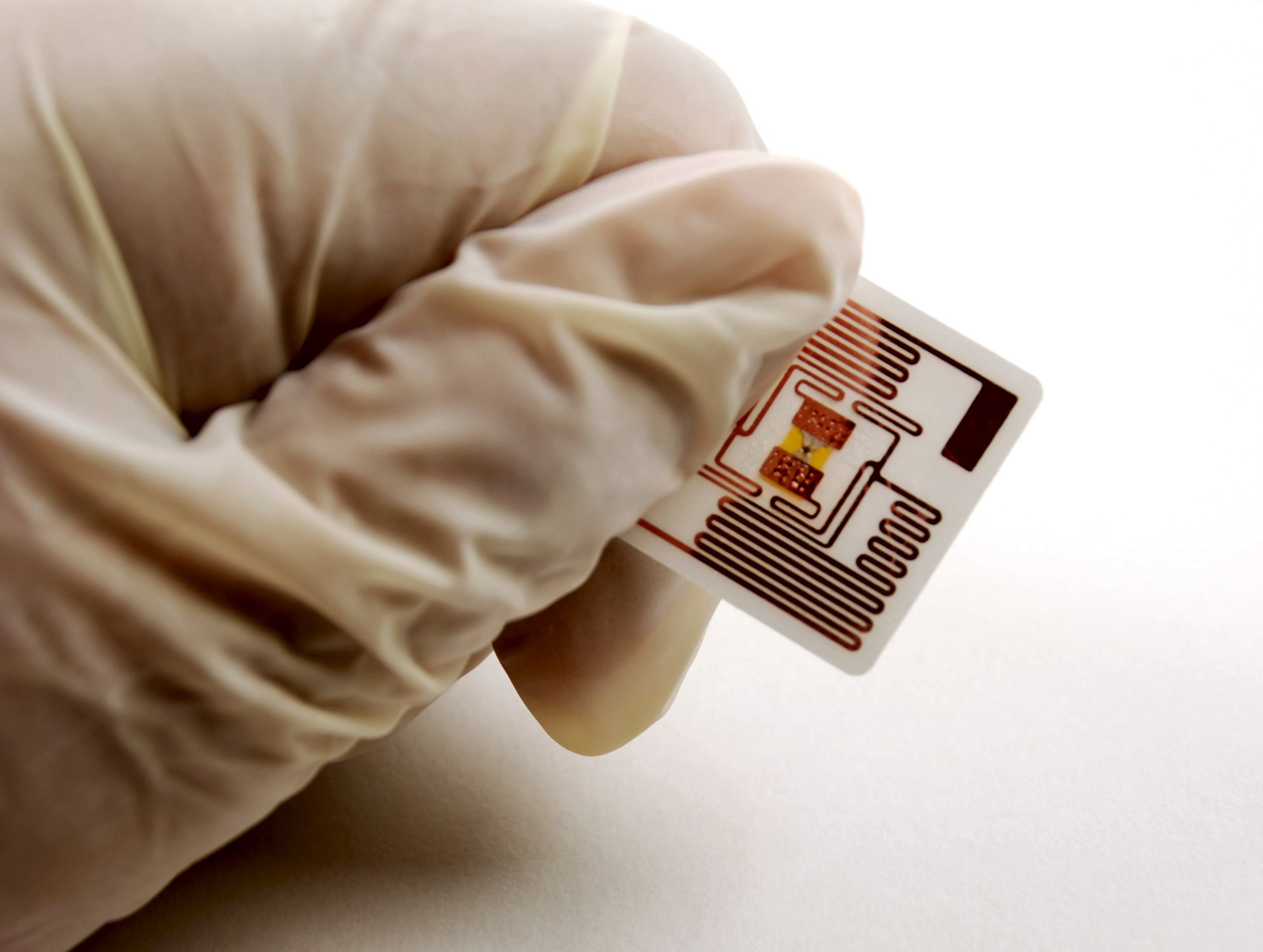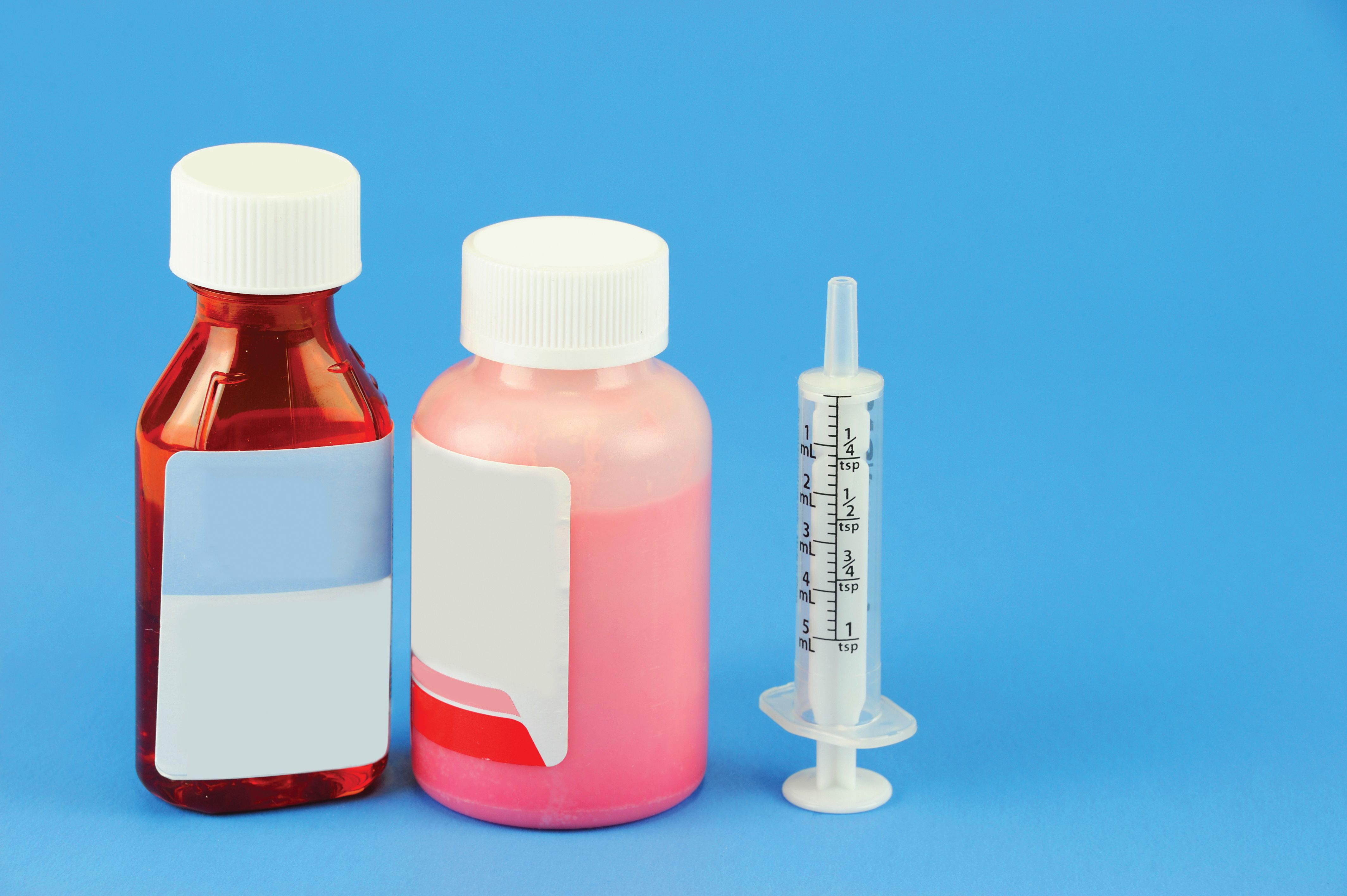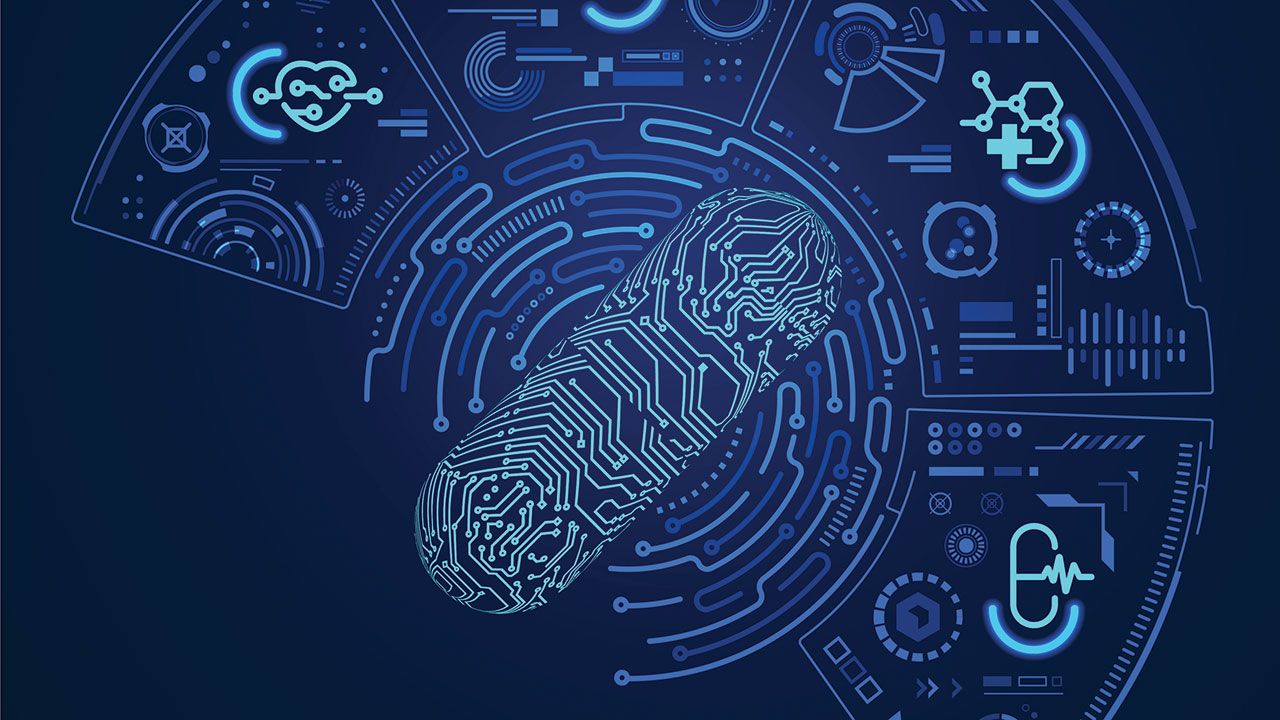News
Article
Pharmaceutical Technology
Exploring a Modern Control Strategy for Wurster Coating
Author(s):
A process control system based on PAT can compensate for variations in particle size, resulting in more consistent coating thickness in a Wurster coating process.
ENRISCAPES/SHUTTERSTOCK.COM
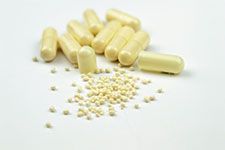
Drug-layered multiparticulates are a common dosage form for extended or modified-release pharmaceutical formulations. Delivered either in capsules, tablets, or as food additives in pediatric or geriatric applications (1), these formulations typically feature a functional coating designed to delay dissolution of the drug in the body.
Wurster coating, using bottom-spray fluid-bed technology, is commonly used to manufacture these formulations, in a multi-phase process. Manufacturing is typically controlled by spraying a fixed quantity of coating factor on the substrate. For a well-developed coating process, spray efficiencies can be highly consistent. However, variability in product quality can often result from raw material variations in the substrate.
This article will discuss research into ways to improve control of the overall process, to minimize substrate raw material and final product variability. In this work, microcrystalline cellulose (MCC) multiparticulates were used as a substitute for a drug-layered substrate and were layered with an aqueous-based enteric coating.
Because coating thickness is the primary critical material attribute influencing dissolution rate (2–4), the goal of this research was to minimize the impact of varying substrate raw material particle size and surface area on the resultant coating thickness. A smart process control system was used in conjunction with process analytical technology (PAT) to monitor and dynamically control key process parameters in order to improve consistency in measured coating thickness at the end of spraying. The automated fluid-bed control system was designed so that the spraying process would stop once a pre-determined coating thickness had been reached that would provide the required dissolution profile.
The approach was demonstrated in application to two different substrate materials, with marginally different particle size characteristics in order to represent real-world raw material variability. Results showed that even a small variation in median diameter can have a significant influence on the total surface area. Experiments documented the differing quantities of coating factor that were required to achieve target growth in each case.
Materials and methods
Materials. Cellets 500 (MCC) (Ingredient Pharm) were used as a substrate material for coating. No API layer was applied for this development study due to processing limitations. A 15% w/w aqueous suspension of 80:20 Surelease:Opadry (Colorcon Inc.) was used to coat the particles. Surelease (aqueous dispersion of ethyl cellulose) was applied as a barrier membrane coating on the Cellets while Opadry (a hypromellose-based coating system) acted as a pore former in the coating formulation.
The Cellets 500 (approximately 500–710 µm) were screened with a 600-µm sieve to create two populations of marginally different sizes (approximately 67-µm difference in Dv50, which is a measure of the volumetric median particle diameter). Both populations fall within the material specification for Cellets 500 and may be considered to represent a batch-to-batch variation for this application.
Three batches of each size were coated to establish the repeatability of results. The three batches of larger size pellets are referred to as L1, L2, and L3, and the three batches of smaller material are referred to as S1, S2, and S3.
Figure 1: Process analytical technology compatible product container with Eyecon2 Particle Analyzer (Innopharma Technology). All figures are courtesy of the authors.

Equipment. Wurster coating was conducted in a Glatt GPCG2 lab-scale fluid-bed system with a six-inch, PAT-compatible, bottom-spray product container. A Schlick 0.8-mm nozzle was used to spray the coating solution with a 4.5-mm air-collar spacing. A type-B orifice plate was used for appropriate fluidization, with a Wurster column height of 25 mm.
The Eyecon2 Direct Optical Imaging Particle Analyser (Innopharma Technology) was used for real-time measurement of the particle size distribution inline, through the lowest window of the product container, as shown in Figure 1. Direct imaging involves capturing images of the particles in-process through the window/inspection port, and running these through a series of image analysis steps to measure the size and shape of each particle present. Analysis parameters were set to fluid-bed coating defaults, with a results integration period of 120 seconds to optimize data for smooth process control.
Control. In-line particle size data and all GPCG2 sensor data were aggregated during processing in real time and used for process control by the SmartFBx (Innopharma Technology) advanced development and manufacturing platform for fluid-bed systems.
Rather than determining the end point of the process’ spraying phase based on when a fixed quantity of coating factor has been added, the SmartFBx controller was configured to monitor particle size growth and continue spraying until a target growth had been achieved.
This target was determined by inline, real-time measurement of the Dv50 of the fluidized pellets during the material preheating phase prior to the start of spraying and comparing Dv50s reported throughout the spraying phase with this baseline value to determine growth. For these experiments the target Dv50 growth was 32.5 µm, equating to a coating thickness of 16.25 µm. This value was chosen because it was the approximate growth achieved in prior experiments during which coating factor had been added to reach a predicted 10% weight gain.
Other key equipment parameters of the GPCG2 were also controlled by SmartFBx within optimum ranges as determined during an earlier design of experiments study. The controller also automatically stepped through process phases when the appropriate conditions for each had been met. A flow diagram for the process phase logic used is presented in Figure 2.
Figure 2: Automatic process controller flow diagram, PI is a proportional-integral control algorithm.

Results and discussion
Two approaches were used to explore the effects of the variation in substrate particle size on the coating process:
1. Measurement of growth in coating thickness for a fixed quantity of coating factor, equivalent to a constant projected weight gain.
2. Control of the total quantity of coating factor sprayed based on Eyecon data to achieve a precise target coating thickness.
Particle size data. Figure 3 aids in visualizing the particle size data used by the process controller by showing an example of the Dv10, Dv50, and Dv90 trends measured by the Eyecon2, in this case from batch S2. Dv50 is the volumetric median particle diameter, while Dv10 and Dv90 define the 10th and 90th percentiles; together these three values provide a simple description of the particle size distribution (PSD). Spraying took place between 16:05 and 18:22 minutes from cycle start, during which time a steady increase in particle size across all three parameters was seen. During the course of each batch, the Eyecon2 made approximately 500,000 particle measurements.
Figure 3: Eyecon2 Particle Analyzer (Innopharma Technology) particle size data for batch S2. Dv50 is the volumetric median particle diameter; Dv10 and Dv90 define the 10th and 90th percentiles.
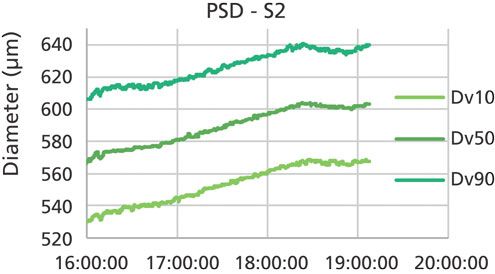
PSD impact on coating thickness. Before examining results from the coating-thickness-driven control strategy, it is important to consider what effect the ~67-µm variation in Dv50 would have had on product quality under a traditional fixed-spray-quantity control regime. To assess this, the measured particle growth for a given spray quantity (1050 g of solution or a predicted weight gain of 9%) was compared across all batches.
In Figure 4, two groupings of points can clearly be seen: batches S1, S2, and S3 with initial size of 570–575 µm, and batches L1, L2, and L3 with initial size of approximately 640 µm. The coating thickness value was derived from half the difference in Dv50s between the start of spraying and the point at which 1050 g of coating factor was added. It can be seen from Figure 4 that the coating thickness for the smaller batches is approximately 3 µm thinner than that of the larger pellets. This result demonstrates that there is a discernible impact on coating thickness due to variation in particle size of substrate under a fixed-spray-quantity control regime.
Figure 4: Coating thickness at 9% weight gain (w.g.) vs. substrate starting size (Dv50).
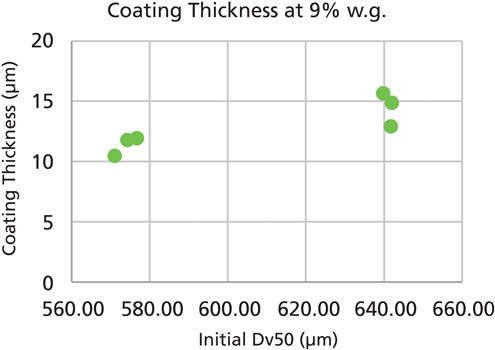
Impact on dissolution. To assess the influence that coating thickness would have on end-product dissolution (assuming that the process target were 9% weight gain), the authors developed a simple mathematical model (4), correlating coating thickness against dissolution for the same Surelease/Opadry coating applied to a chlorpheniramine maleate (CPM) drug-layered particle. The relevant equations from the model (4) are:
D15 = 0.053Tc2- 4.524Tc+ 98.71
D30 = 0.007Tc2- 2.61Tc+ 100.2
D60= 0.0005Tc2- 1.7416Tc+ 101.8
D120 = -0.017Tc2- 0.455Tc + 100.3
D240 = 0.008Tc2- 0.163Tc + 99.74
where DTindicates dissolution percentage after the given time in the water bath, and Tcis the measured thickness of the coating at the time the sample was extracted from the process.
Figure 5 shows the variability that would be expected for these functional coating thicknesses applied over a CPM-coated bead.
Due to the relatively thin coatings and function of Opadry as a pore former in this formulation, these dissolution rates are representative of a relatively fast extended/modified-release product, such as one targeting a specific area of the gastrointestinal tract. For a slower release coating, however, similar variations in dissolution but over longer timeframes would be expected. Variation in this case is >10% at the 30-minute dissolution time point and 9% at 1 hour.
Figure 5: Predicted chlorpheniramine maleate dissolution profiles for each batch at 9% weight gain (w.g.).
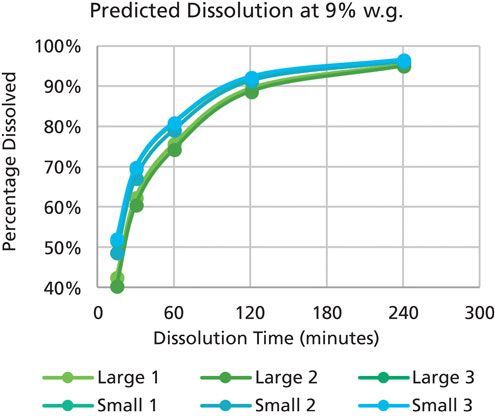
Variation in required coating quantities. Using the control strategy of spraying until a target particle growth is reached resulted, as expected, in consistent coating thicknesses with a variation in the total amount of coating solution required for each batch. This result can be linked to the variation in the particle size of the substrate, and may also be influenced by other parameters, such as fluidization patterns, surface porosities, and spray efficiencies (5,6).
Figure 6 demonstrates a clear downward trend in coating solution requirement from the “small” runs (left-hand cluster) to the “large” runs (right). This behavior is as expected due to the greater total surface area present in the smaller particle size batches. The behavior demonstrates the control strategy’s ability to effectively compensate for these variations without the need for formulation-specific empirical models.
Figure 6: Total coating solution required per batch to reach coating thickness target. Dv50 is the volumetric median particle diameter.
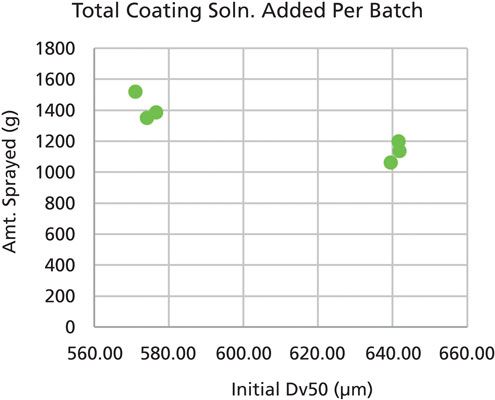
Predictive model results. The benefit of basing these control decisions on PAT measurements can be demonstrated by examining the results of a simple prediction model relating coating factor requirements to initial substrate particle size. Figure 7 displays the experimental results compared to the predicted quantities for a range of starting Dv50s based on a calculation of the ratio of final coating layer volume to substrate volume.
Figure 7: Coating factor required vs starting Dv50 (the volumetric median particle diameter), for experimental batches and a simple prediction model.
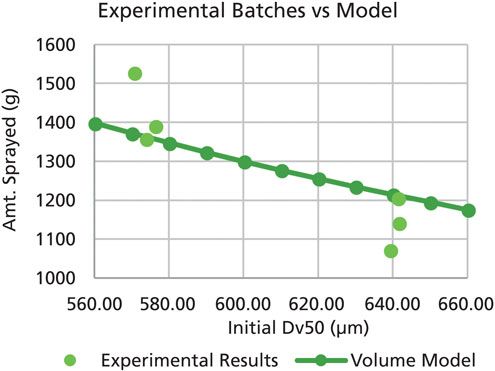
Figure 7 shows an agreement in overall trend between the experimental and predicted results, although there is considerable variation. Because each batch was coated to a constant coating thickness, the variation in quantities sprayed could be attributed to variations in other processing factors such as spray efficiency, substrate porosity, particle mass effects, PSD width, and any agglomeration or attrition present in the process.
Making control decisions based on real-time process measurements to track true particle growth eliminates the need for complex, formulation-dependent empirical models to calculate and compensate for such sources of variability. This traditional approach would be necessary if spray quantities were being controlled solely based on off-line raw material size measurement.
Conclusion
With traditional process control methods, variation in substrate particle size impacts coating thickness on a meaningful scale. Dissolution model results indicate that the tested size difference of ~67 µm in Dv50 would have resulted in more than 10% variability in quality control dissolution test results in which pellets were coated to 9% weight gain.
A control strategy using real-time particle size distribution measurement to calculate growth, however, has been shown to provide consistent coating thickness results for varying substrate sizes. Similar results could not be achieved using offline measurement without the use of complex empirical models and variability due to other process attributes.
Additional work is planned to apply this control methodology to an API-coated substrate and validate the predicted lower variability in quality control dissolution testing.
Acknowledgements
The authors thank Colorcon inc. for their supply of the Surelease and Opadry materials used in the coating solution, and Glatt GmbH/Ingredient Pharm for the supply of Cellets.
References
1. M.P. Ratnaparkhi and J.P. Gupta, Int. J. Pharma Research & Review 2 (3) 11-21 (2013).
2. L. Ho et al., J. Control. Rel. 127 (1) 79-87 (2008).
3. R. Langer, Accounts of Chemical Research, 26 (10) 537-542 (1993).
4. P. Patel et al., “Solid Dosage Drug Development and Manufacturing” Supplement to Pharm. Tech. 41, s20-s25 (2017).
5. R. Wesdyk et al., Int. J. Pharm. 65 (1-2) 69-76 (1990).
6. C.A Lorck et al., Eur. J. Pharmaceutics & Biopharmaceutics 43 (2) 149-157 (1997).
Article Details
Pharmaceutical Technology
Vol. 43, No. 8
Pages: 38–41, 64
Citation:
When referring to this article, please cite it as C. O'Callaghan et al., "Exploring a Modern Control Strategy for Wurster Coating," Pharmaceutical Technology 43 (8) 2018.
About the authors
Chris O’Callaghan* is senior product manager at Innopharma Technology, Dublin, Ireland, ocallaghanc@innopharmalabs.com; Ian Jones, PhD, is founder and CEO of Innopharma Technology and Innopharma College of Applied Sciences, Dublin; Piyush Patel, is formulation technologies manager at Colorcon, PA, ppatel@colorcon.com; and Edward Godek is manager, Process Technology at Glatt Air Techniques, NJ, info.gat@glatt.com.
*To whom all correspondence should be addressed
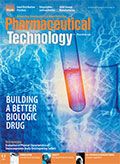
Newsletter
Get the essential updates shaping the future of pharma manufacturing and compliance—subscribe today to Pharmaceutical Technology and never miss a breakthrough.


